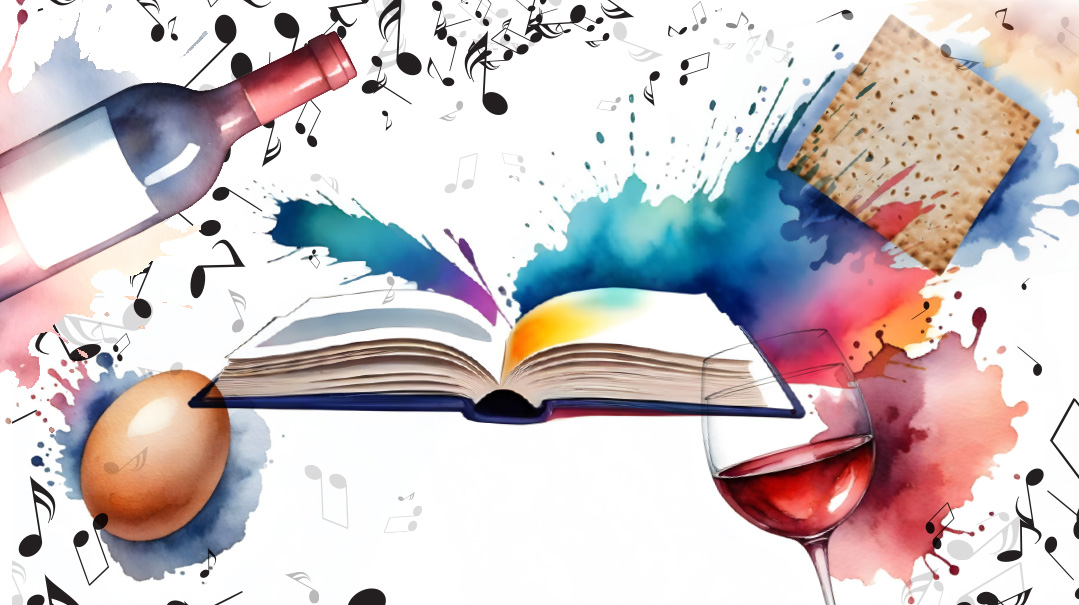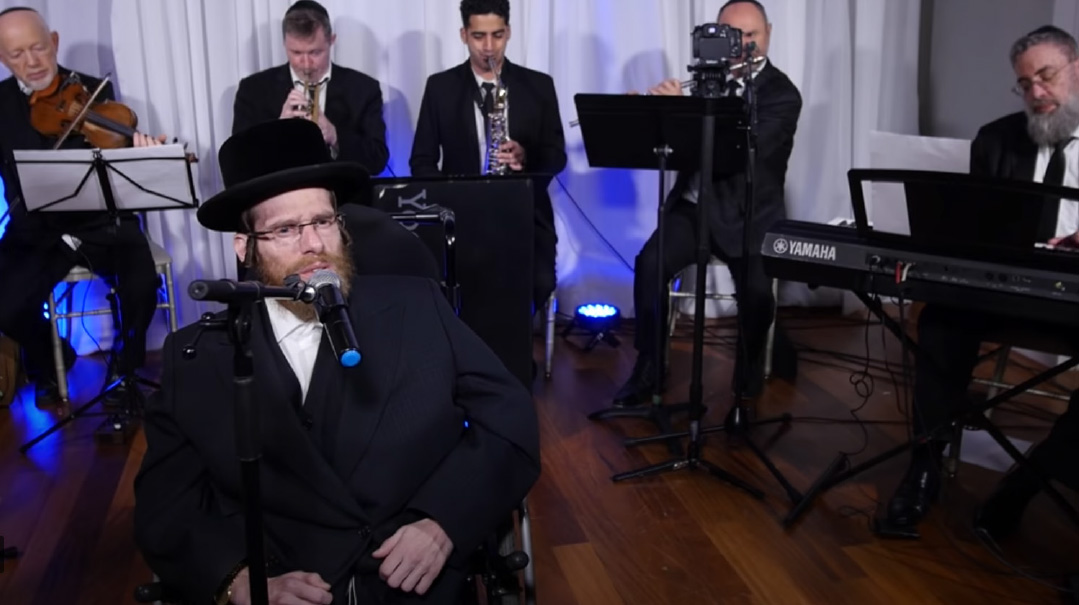What Are You Singing at the Seder?
| April 16, 2024There’s always a story behind the songs that connect us to our own Pesach experience

The words of the Haggadah have been passed down through the generations for the last two millenia, but each family has its own minhagim and traditions when it comes to the melodies and the music. Whether your style is traditional, heimish, or contemporary, there’s always a story behind the songs that connect us to our own Pesach experience
The Zeide’s Krechtz
KADEISH URCHATZ
HERSHY ROTTENBERG’s soulful, meditative “Kadeish Urchatz” helps create some of the magic as the night begins. Hershy wanted to carry himself back to the childhood Seder led by his grandfather, a Holocaust survivor.
“My zeide had this little krechtz — yuh buh buh bum, oy vey — that he’d interject throughout the Seder. As he retold the Haggadah together with his own stories of miraculous survival in the concentration camps, he’d cry, and then repeat this little Vizhnitzer teniyele [musical phrase] that he’d brought along from his childhood home.”
One of the Belgian chassid’s first compositions, “Teniye’le,” made famous by Shulem Lemmer, tells of a chassid on the way home from his rebbe, wondering how he’ll get through the year after the uplifting Yom Tov as he holds the inspiration in a few short bars of the Rebbe’s teniyele. Hershy thought he would do something similar with his grandfather’s teniyele, framing it in an original prologue.
But once the introduction — “Pesach oif der nacht, ven er Tatte kumpt aheim fun shul…” — was written, a simple but moving melody followed, and instead of the old Vizhnitz piece, the simanim of the Seder came to mind: Kadesh, Urchatz, Karpas, Yachatz…
“It felt like a nice nusach for our family to sing,” Hershy says, “so I sat with my guitar and asked one of the children to video it on their camera.”
He only sent it to a few people, but by Chol Hamoed, the regards started pouring in. Families had enjoyed the warmth of the new niggun around the Seder table, and kumzitz clips from Chol Hamoed followed. The following year, it seemed like everyone was singing it. Motty Vizel’s production with Malchus Choir put the song on the map for the general public, and Moshy Kraus’s Yiddish Nachas choir made a stunning Friday night version of the song to the words of “Shalom Aleichem” instead of “Kadeish Urchatz” on the first Shabbos Nachas album.
“Now, when we sing it at home at the beginning of the Seder, I think to myself, “Shkoiach, Eibeshter, for giving me this song that so many are singing tonight along with me.”
Words That Fit
BORUCH HAMAKOM
From the vintage 1971 Neginah Orchestra Awaken record, the upbeat and child-friendly “Boruch Hamakom” has made its way into classrooms and Seder tables over the last half century. YISROEL LAMM, who arranged and directed the album, remembers selecting the song, a tune to a line of the Haggadah that people might have quickly said and moved on.
“Neginah was a fledgling orchestra, and we were planning our first album,” Lamm remembers. “The industry was nothing like it is today, and there weren’t hundreds of songs to choose from. I remember we received some niggunim from Rivi Koenigsburg in Boro Park, and we liked them. But this one was wordless, and finding words to fit a tune takes some time and inspiration. My twin sisters Devory a”h and Malky a”h, who heard that we were looking for words, were playing guitar and came up with the idea to set it to “Boruch Hamakom.” We did, and 50 years later, we can say it was a good call.”
Enough Is Enough
DAYEINU
Although most people today don’t even remember it, back in the 1940s and 1950s, Cantor MOSHE OYSHER’s “Dayeinu” (“Dayeinu Da-yei-nu…”) was a popular music piece. When YERACHMIEL BEGUN approached Yisroel Lamm to create a memorable musical Haggadah production for the Miami Experience 4 in 1994, Yisroel thought of using Moshe Oysher’s “Dayeinu Da-yei-nu DaYEInu DaYEInu” and merging it with the ubiquitous “regular” Dayeinu tune to create an original and complex effect. Billed as “A Magnificent 100-Voice Presentation of Works from the Haggadah,” “Dayeinu” followed an original “Avadim Hayinu” piece, almost ten minutes long, featuring fast and slow parts, a cantorial shtikel, and spectacular vocal arrangements with full adult and children’s choirs.
Yitzy Spinner, who was a choir soloist, remembers the Haggadah section as an ambitious production. “Merging an adult choir with a children’s choir is never easy, especially with layered harmonies and intricate orchestrations. It required significantly more rehearsal than anything I’d experienced, but looking back, it clearly paid off.”
Where’s Moshe?
PHARAOH IN PAJAMAS
How many families sing a round of “Pharaoh in Pyjamas” to keep the kids happy after they’ve covered the Makkos and everybody’s spilled some wine from the kosos? This song came into being one year when Rabbi Alter Yachnes a”h, a cheder rebbi in Jerusalem, taught his class parshas Bo. The pasuk says that Pharaoh got up at night, and Rashi comments, “from his bed.” As Rebbe Alter left his classroom and met the rebbi of the next class, they both came out with the line, “Pharaoh b’pyjama be’emtza halaylah.” The rebbis got one boy to dress up in pajamas and a crown and go search for Moshe and Aharon, while the entire class gave him false directions. The kids loved it. All that was left was to find a tune, and Rebbe Alter soon hit on the catchy “Baruch Elokeinu Shebaranu Lichvodo,” composed by Rav Refael Shapiro (1837–1921), rosh yeshivah of Volozhin and son-in-law of the Netziv. Rebbe Alter reported that more than once, people asked if he was aware that his “Pharaoh B’pyjamas” tune had been adopted for “Baruch Elokeinu.”
In Every Generation
VEHI SHE’AMDAH
Many families sing “Vehi She’amdah” in a traditional tune that may have come from the Stoliner chassidus and was sung in the court of REBBE YISROEL (“The Yenukah”) of Stolin. A variation of the same tune was taught by the LUBAVITCHER REBBE at a farbrengen in 1955.
In a broad range of chassidic circles, though, the “Vehi She’amdah” that comes from Bobov is the standard niggun for this part of the Haggadah, with its high part full of happy, spirited conviction — “Shelo echad echad bilvad amad aleinu, shelo echad echad bilvad amad aleinu, shelo echad echad bilvad amad aleinu, amad aleinu lechaloseinu…” The niggun was composed by Rav Bentzion Halberstam, the KEDUSHAS TZION OF BOBOV, who was murdered by the Nazis in 1941.
In prewar Bobov, close to a thousand bochurim would come and join the Rebbe for Pesach, while the married chassidim stayed home to lead the Sedorim for their families. There weren’t enough seats, but the young chassidim were satisfied to stand for hours, matzah taschen hanging on their shoulders, in order to be with the Rebbe and experience his elevated Seder. When it came to “Vehi She’amdah,” the singing of the Rebbe’s niggun was accompanied by dancing.
Today, “Vehi She’amdah” is sung in Bobov not just at the Seder, but also at the tishen which take place each night of Chol Hamoed. The song is sung repeatedly for around half an hour, and dancing is train-style, not holding hands but with a hand on the next person’s shoulder. Since there is no space to form a circle, the lines of dancers zig-zag back and forth across the beis medrash.
The composer of the more modern Vehi She’amdah that made waves across the Jewish world when it originally emerged on Yaakov Shwekey’s Ad Bli Dai album in 2009 is the soft-spoken musician YONATAN RAZEL. Yaakov approached Razel when looking for some Sephardic-flavored music, but after hearing a few of Razel’s compositions, he couldn’t find anything that worked for the niche he was looking for. But when Shwekey’s then-producer Yochi Briskman asked Razel if he had any composition that he hadn’t used yet, Razel took out “Vehi She’amdah.”
“I told them I hadn’t really worked the song through, and I didn’t know why it hadn’t taken off,” Razel remembers. “I played it, and then suddenly Yochi said, ‘I know why it hasn’t become popular. The words ‘V’HaKadosh Baruch Hu matzileinu miyadam’ are not in the right place. Sing them at the end, as a rousing conclusion, and you’ll see how it sounds.’ Yochi arranged the song in a different order, and he was right on target.”
What Did the Sea See?
B’TZEIS YISRAEL
Starting Hallel on a full kos of wine, ready to sing praises for the miraculous events recounted on this holy night, the words “B’tzeis Yisrael miMitzrayim” stand out. The almost-universally known “B’tzeis Yisrael” sung today is one of many compositions on this section of Hallel by Rav Shaul Yedidyah Elazar Taub, the IMREI SHAUL OF MODZHITZ. This one was composed in Poland, before World War II, and the Imrei Chaim of Vizhnitz heard it from the Modzhitzer Rebbe when they met in the resort of Marienbad, so that it spread quickly to Vizhnitz as well. REB BENZION SHENKER recorded the song on the Modzhitz Shalosh Regalim record in 1958. Over time, the melody was simplified and the tempo increased, the tune evolving into the more easily-singable version popular today.
I’ll Live On
LO AMUS
A popular Hallel tune both at the Seder and in shul is RABBI BARUCH CHAIT’s “Lo Amus,” with its slow, meditative beginning, followed by a more rousing, rhythmic “Pischu li shaarei tzedek…” The song was composed by Rabbi Chait at the request of Menachem Ehrental, a young Israeli boy who had been battling leukemia since he was a baby. His soul was drawn to music, which kept him going through years of terrible pain and treatments. A rotation of singers would visit Menachem every Motzaei Shabbos, and on one particularly painful week, Menachem asked Rabbi Chait to compose a new niggun.
“I said, ‘Menachem, I can’t promise, it doesn’t always go. But I can try.’ I asked him which words he wanted me to sing,” Rabbi Chait remembers, “and he gave me those words — ‘Lo amus ki echyeh.’ I went home that night and sat down in the dark with a candle, and the niggun emerged.”
Rabbi Chait sang the new song for Menachem together with Mordechai Ben David. Later, after Menachem passed away, it was performed at Binyanei Ha’umah at a concert to benefit the Ehrental’s newly-established organization for cancer patients — Zichron Menachem. Unlike so many other Chait classics which have been phrased and interpreted differently by various singers at various times, “Lo Amus” has retained its original flavor no matter who sings it. “Today it’s still sung the way we did it in Menachem’s house, when Mordechai and I sang it together,” Rabbi Chait says.
What Can I Give in Return?
MAH ASHIV
The universally sung “Mah Ashiv” composed by RABBI AVIEZER WOLFSON was originally recorded by Leibele Haschel on his solo album in 1980, with Moshe Laufer’s slow and serene musical arrangement. When Suki and Ding decided to re-record it with Mordechai Ben David on their all-star Hallel album, Rabbi Suki Berry says that they didn’t even know who the composer was.
“While formulating the arrangement, I realized that like so much of Tehillim, the words were building up momentum, so when I accordingly slowly lifted the tempo and the energy, I felt that it really fit. When I’m in shul, and people sing it like that — getting stronger and a bit faster as it goes along — I feel a bit of ‘Baruch shekivanti.’ It was actually distressing when I found out that Rabbi Wolfson, who lives in Savion today, composed the tune as a slow song all along and did not appreciate the change. Just recently someone approached me to record it for him as a slow song. I think, as with everything, we are just shluchim, and the MBD presentation is what people needed at that time.”
In Bobov, the Kedushas Tzion’s elaborate composition for “Mah Ashiv” is another highlight. At the ne’ilas hachag, the final tish of the Yom Tov on Acharon shel Pesach afternoon, the last song before the dancing begins is “Mah Mah Mah Mah Mah Ashiv Lashem.” A complicated piece, it takes 12 to 15 minutes to sing it through, and with no choir, the entire crowd joins in.
There’s also the Vizhnitz “Mah Ashiv,” another complicated tune that takes about 10 minutes to sing finish.
Closure
CHASAL SIDDUR PESACH
The most widespread tune for this seminal paragraph was often assumed to be a traditional song whose exact origins are unknown. But research in recent decades attributes it to Karlin-Stolin, where it was apparently already sung at the court of REBBE YISROEL OF STOLIN.
Another popularly sung niggun to these words is Reb Hershel Goldstein’s composition for the Yom Kippur piyyut, “Ki Hinei Kachomer,” made famous by Rav Sholom Schwadron. On Lev Vanefesh I, Abie Rotenberg set “Chasal Siddur Pesach” to this tune, five years after he used the tune for his memorable sefer Torah song, “The Place Where I Belong,” on Journeys 1.
At the tish of REBBE AHARON OF BELZ, at the close of the last day of Pesach, “Chasal Siddur Pesach” was sung several times, in three different holy melodies, two of them to a niggun used after Chanukah lighting, and one from the fourth hakafah of Simchas Torah. This was followed by uplifting dancing. The Belz chassidus retains these special tunes.
Waiting for the Temple
ALMACHTIGE G-TT
One time-hallowed way to wind up the Seder on a high note is with “Almachtige G-tt.” This version of “Adir Hu” is an ancient ode found in the Haggadah of the Shelah HaKadosh, Rav Yeshayahu ben Rav Avraham HaLevi Horowitz ztz”l. It is written in archaic Gothic German, the language of the time, mixed with Judeo-German.
This song was traditionally sung by the Jews of Germany and Austria-Hungary (Oberland) at the Seder at the point where “Adir Hu” appears in the Haggadah, to the same tune. Its chorus, “nun bau, nun bau, dein temple shiroh” [now build Your Temple quickly] is repeated with longing. This song is so central to the Sedarim that upon leaving shul on Seder nights, generations of Jews would wish each other, “Bauen zi gut!”
Every Mouth Gives Thanks
NISHMAS
Yehuda Green was at the Kosel late one night in 2003, when someone asked if he could join a minyan.
“I’ve just finished Maariv,” Yehuda replied.
“It’s not about Maariv. We’re saying Nishmas.”
Yehuda had never heard of it before, but apparently there was a new minhag to say Nishmas at midnight, especially at the Kosel. He was convinced to join in, especially when he recognized two distinguished tzaddikim of Yerushalayim in the group.
“We started at midnight, in such an elevated atmosphere. People were crying, others smiling in happy bliss — it felt like the Shechinah was there. And then a niggun came to me, and I started to sing to myself “Nishmas, nishmas kol chai…” I knew it was an amazing song, but I was worried I’d forget it. I had to keep singing and singing while I ran home. I think the friend I was walking with thought I was a little crazy, because I couldn’t stop singing to say a word until I got home and recorded myself.”
Rav Moshe Horwitz, rav of Zvehil in Beitar, was a lofty talmid chacham and grandson-in-law of Rebbe Mordechai of Zvehil. When he passed away in 2020 at age 65, he’d left behind dozens of niggunim that he composed (his father, Rav Pinchas Horwitz, was also an avid composer). His most well-known niggun, the inspiring and hopeful “Ki Kol Peh” — “Ki chol peh lecha yodeh… vechol loshon vechol loshon lecha sishova …. Vechol berech vechol berech lecha sichra” — was released on Lechaim Shira in 2008, and is popular as a dance tune — and as a rousing end to Nishmas.
Yearning for Yerushalayim
SOL A KOKOSH MAR
ASthe long night draws to a close, Hungarian families turn to the song written by the Kaliver Rebbe that spread throughout prewar Hungary, a moving poetic expression of the yearning for Geulah. The first rebbe of the Kaliver dynasty, Rav Yitzchak Isaac Taub (1744–1821) of Nagykálló, Hungary, was a great rebbe and locally known, like Dovid HaMelech, as “the Sweet Singer of Israel.” He composed many popular chassidic melodies, often adapting Hungarian folk songs and adding Jewish words. He taught that these specific tunes originally came from the Beis Hamikdash and were lost among the nations over the years, and that he found them and returned them to the Jewish people. He said that the proof of this was that the gentile who would teach him these songs would forget them as soon as he learned it.
One of these tunes — arguably the most famous — is “Sol a Kokosh Mar.” It spread throughout Hungary as a song of dveykus and hope in the spoken language, using the parable of a beautiful bird who wants to return to its home, Yerushalayim, and concluding with “Yibaneh hamikdash, ir Tzion temaleh… then, it will happen.” (Some versions continue with the words “Why has it not yet happened...umipnei chata’einu galinu mei’artzeinu...”)
The Kaliver Rebbe who survived the war, Rav Menachem Mendel Taub, sang this song at hundreds of weddings and events over the years, bringing the holy legacy of his ancestors forward to a new generation, until his petirah in 2019.
Countdown to Hashem
WHO KNOWS ONE
It’s a COUNTRY YOSSI classic, and according to Yossi Toiv (a.k.a. Country Yossi), it was the first song he ever wrote.
“I was about 16 years old,” Yossi remembers, “it was close to Pesach and I was looking through the Haggadah when I came to “Echad Mi Yodeya.” At our family Seder we always sang the Hebrew words with a fast, catchy tune. But I thought the English words would be fun to sing too, so I decided to give it a shot. First came the chorus hook ‘One is Hashem,’ repeating three times, then the rest of the numbers just followed naturally.”
Yossi first introduced the song at an NCSY convention, and after he saw how well it went over, it became part of his repertoire as he traveled around the country doing kumzitzes.
“Eventually,” says Yossi, “both Shelly Lang and Uncle Moishe recorded it, neither of them even knowing that I wrote it! So we eventually put it on a Kivi and Tuki album in order to set the record straight. Decades later, it’s very rewarding to hear that many families are still singing it at their Seder – a songwriter can have no greater nachas.”
Thank you to Rabbi Binyomin Neufeld, Reb Moshe Eisenberg, Velvel Schmeltzer, and Yaakov Brown for their assistance with research for this article.
(Originally featured in Mishpacha, Issue 1008)
Oops! We could not locate your form.







